‘I have a slight empathy with dust. If I see it I don’t rush to clear it up.’ Rose Wylie looks about the dining room of her 17th-century cottage in Kent, where she has lived for some 50 years. It has a cold brick floor and a ceiling of slanted glass panels, which look as if they have never been cleaned. Yellowy November light streams through the glass, softened by watermarks and the dark blotches of lichen and dead leaves. Outside, the garden has been left to its own devices, and presses close to the house, a lattice of shoots and branches. Some have snaked in at the windows and up to the ceiling, where they have dried and are now festooned with cobwebs. More sprigs of foliage have been stuffed into vases and placed along the windowsills; these, too, have dried into apricot-coloured crispness. On the table, as if arranged for a still life, is Wylie’s breakfast tray: mismatched coffee cup and saucer, crested Folkestone jug, two-handled silver sugar bowl, and the remains of porridge in a blue-edged scalloped dish. The effect of all this is a kind of well-worn, shabby elegance. Wylie, with her dark lipstick, green cardigan and choppy grey hair, smiles mischievously, and waves away the mess.
I’m visiting the painter at home as she prepares for ‘Let It Settle’, an exhibition at the Gallery at Windsor in Vero Beach, Florida (28 January–30 April). It’s one of three international shows in 2020, proof of her ever-blooming reputation. Though she’s quick to reject the focus on her age – ‘I just think it’s unnecessary, it doesn’t matter’ – her late-life success is remarkable. She first studied art in the 1950s, but gave it up in order to look after her children, only returning to the Royal College of Art for an MA in 1979. For more than 10 years, she worked in obscurity, the paintings stacking up on the floor in her studio, until she began to be noticed for competition entries. Then recognition came quickly. In 2014, she was awarded the John Moores Painting Prize; three years later, she had a retrospective at the Serpentine Sackler Gallery in London; and last year, at the age of 84, she received an OBE for services to art. ‘Suddenly, it all came together,’ she says. ‘But the work is no different, and I’m no different.’
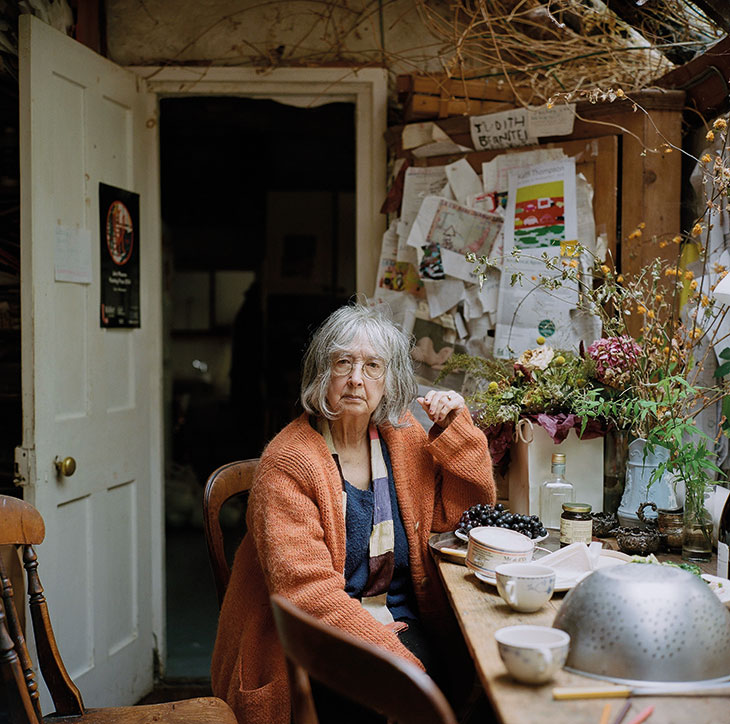
Rose Wylie photographed in her cottage in Kent in November 2019. Portrait: Toby Glanville
The work for which she has become known is large-scale and exuberant. Wylie paints with graphic simplicity, depicting scenes as if from storybooks or comic strips: a puffed-up and expectant queen surrounded by pansies (Queen with Pansies (Dots), 2016); the uniformed figures from a Tarantino film (Inglourious Basterds (Film Notes), 2010); a bare-backed Nicole Kidman on the red carpet (NK (Syracuse Line-Up), 2014); a girl eating a chocolate biscuit (Choco Leibnitz, 2006). Her figures are rounded and cartoonish, with thick outlines and exaggerated features, their limbs often caught mid-motion. She uses colour boldly and simply, and often adds text to her canvases in a scrappy but legible hand, serving as caption or commentary on the scene unfolding. She eschews art-world artiness; instead, the paintings are unaffected and joyful, and critics are captivated.
Wylie always begins with drawing, working downstairs at the dining-room table, often late into the night, before moving upstairs to paint. She shows me a series of prints on which she’s currently working, each one made up of two sheets of A3, laid side by side like the pages of the diary from which they’ve been photocopied. They show sketches of a female figure, perhaps dancing, in a bulb-shaped dress, and the words ‘Black frock from Oxford 1956’ in Wylie’s distinctive, unruly hand. On one section, a map of the world is visible through the drawing, while elsewhere she has added patches of white paper, collaging over certain areas – the woman’s skirt, some of the lettering – until it seems she’s got it right. Finally, each has been worked up in a different bright colour: green, blue, pink, and yellow. She is characteristically unpretentious about materials, working on printer paper with coloured pencils. ‘If you were at school, they would say these little pencils were not appropriate to use on a bigger scale,’ she says. ‘But it’s quite nice to use something inappropriate. It takes a long time. The colour is soft, like an old print; it’s not Technicolor, it’s not Hollywood. It’s got some other quality which rather fits.’
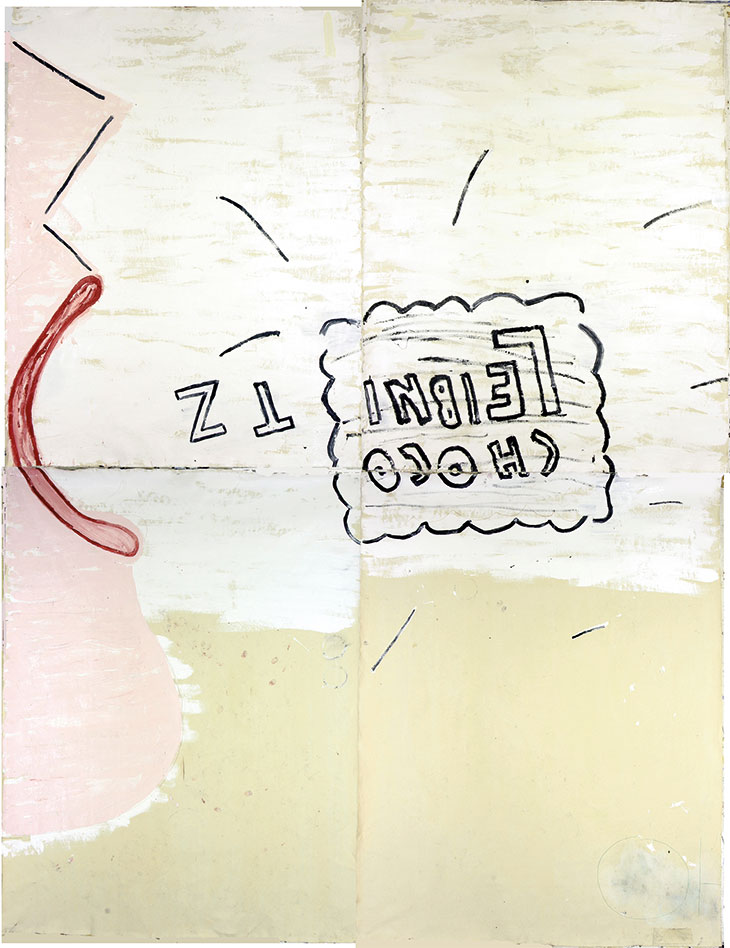
Choco Leibnitz (2006), Rose Wylie. Courtesy David Zwirner; © Rose Wylie
Wylie keeps a diary, which she uses as a sketchbook – ‘I do diary all the time, it’s nothing unusual’ – before transferring the pages on to canvas. She digs out another – a standard-looking engagement diary, with a black cover – to show me. Inside, day-to-day appointments and the addresses of curators and editors jostle with drawings: a drooping female figure, a horse, a line of buildings in biro. On one page, she has drawn her cat, Pete, as he lay across the desk in front of her. It’s a hasty sketch, a scrabble of thick pencil lines, but full of life, capturing the warmth of his sleeping heft. Above him she has written, ‘Lovely big slim Pete.’ It’s a joke, she tells me, as people often remark on his size. ‘But he’s not fat, he’s delightful,’ she croons.
She often comes across an idea for a painting in this way, making sketches after watching films, or after seeing something in a newspaper or on the street, or from memory. It’s a method that relies on chance, on her receptivity to the world around her, particularly the Kent village in which she lives. ‘I just see something,’ she says. ‘A cat. A bird. A woman’s hat. There was this amazing girl the other day, running in the field behind the house. She was picking up her legs like an ancient Egyptian, pointing her toes. She was terrific. I could have done her.’ She started Black frock from Oxford after remembering a dress she had bought from the designer brand Frank Usher in 1956. It was made from black silk with a ruched skirt. But a year later she met and married the painter Roy Oxlade, ‘a wonderful, rebellious kind of Marxist’, and the dress, with a silhouette belonging to another era, was never worn. ‘The frock didn’t fit the context that I was in, there was no opportunity for it,’ she explains. ‘But it’s come up now in the pictures.’
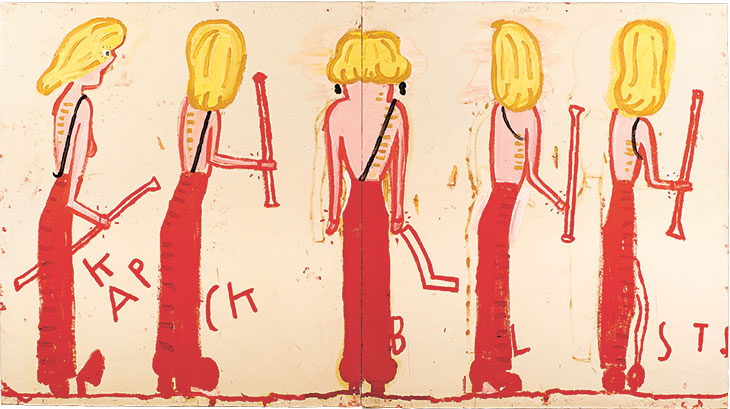
NK (Syracuse Line-Up) (2014), Rose Wylie. Courtesy David Zwirner; © Rose Wylie
Upstairs, in her studio, several more versions of the print are pinned to the walls and spread over the floor. Some have been collaged, others painted. The room is claggy with paint, the table heaped with pots out of which poke laden, unwashed brushes, the chairs crusty with it, and the walls and windows covered in drips and scumbled marks. Underfoot, the floor bounces, carpeted with a thick layer of newspaper. She shows me a palette knife, the handle of which has never been washed. Its slim blade juts out of a protuberant, vegetable-like mass, sludgy in colour and tacky to touch. ‘It’s extraordinarily good, isn’t it?’ she says, laughing. ‘A real relic, a museum piece. It really is the shape of my hand.’
In here, it is easy to sense the verve and vigour with which Wylie works. She staples unprimed canvas directly on to the wall, doing away with ‘all that business of tightening it up and stretching it’, preferring it looser and a little frayed. ‘I just like it, all that curly stuff along the top. It’s like a curtain. It always has a bit of buckle.’ Her disinclination to tidy is another facet of this energy; she feels exhilarated and free when she lets things accumulate in her studio. ‘When you’re young you’re told to clear up,’ she tells me, ‘but the whole business about being an artist is you don’t have to do what you’re told to do. There are no rules. I just come in and do something, and then I put it on the top. When it really starts to get under my feet, when I can’t work, I’ll move it. Otherwise I enjoy it. It’s liberating.’
Wylie objects to dogmatism, particularly when it comes to her work. Pointing to one of the prints, on which the woman’s face is enlarged and heavily outlined, she says: ‘It looks like a crap figure and like some child has done it. In fact, it’s quite difficult to do.’ The critical vocabulary applied to her painting often has recourse to limp descriptors of the childlike: intuitive, crude, unpredictable. In 2013, reviewing the Royal Academy’s Summer Exhibition in the Evening Standard, the critic Brian Sewell went so far as to describe Wylie’s entry as ‘a daub worthy of a child of four’. ‘They’re not childlike,’ she shoots back. ‘It’s a dirty word for a lot of art people. But if you don’t do what’s considered to be good drawing, in the sense of the European development of art, then that’s what it’s called. In fact, it hasn’t been governed by rules, it’s freer, it’s not highly skilled in that sense. But people are sloppy, shallow, lazy, and frankly crap. Can you see how annoying it is?’
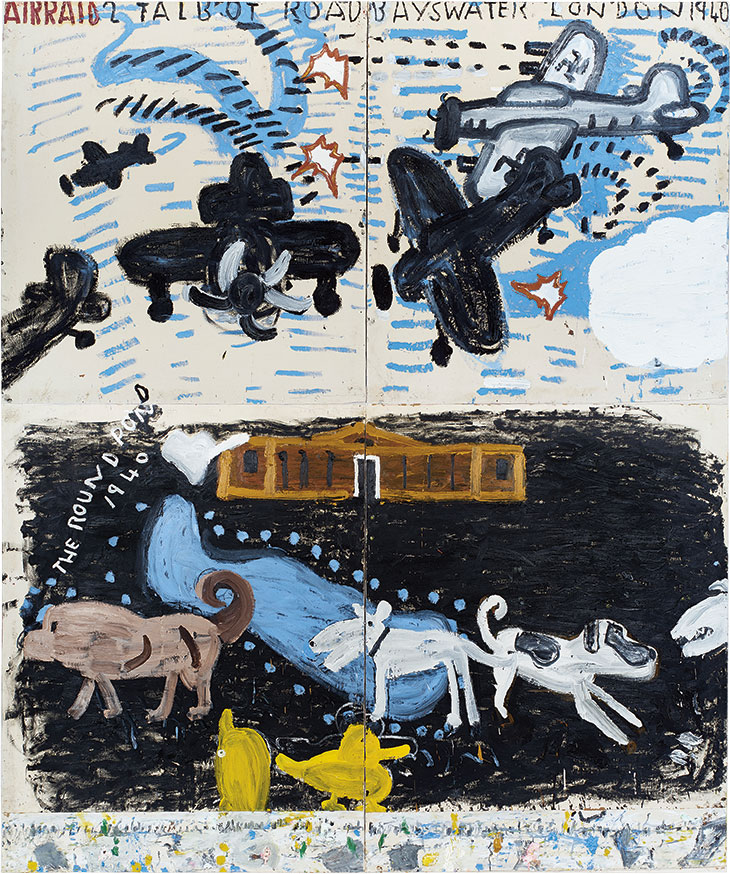
Park Dogs & Air Raid (2017), Rose Wylie. Courtesy David Zwirner; © Rose Wylie
Instead, Wylie works with Matisse in mind: ‘He said, “Use everything at your disposal”.’ Like Philip Guston, to whom she’s often compared, she engages with the aesthetics of cartoon, unashamedly ramping up certain figurative elements in her paintings. ‘If a man is running you might see little blobs of sweat or whizzing marks,’ she explains. ‘A realist would never do that. They just paint what they’re looking at. But if you go along with Matisse, as children do, you use everything. If a child wants to draw a mother with a big head, for emphasis or because the head has a particular significance, then they’ll draw a figure with a big head. It’s breaking a rule, but it’s only the rule of proportion, a realist rule. That’s what I do.’ And in so doing, Wylie delivers something much more acutely observed. In Park Dogs & Air Raid (2017), for example, she depicts the Blitz (which she experienced aged four, living in Kensington) from the child’s eye view. Perspective is flattened, giving the viewer the Round Pond and the frolicking dogs as well as the planes overhead, their speed accentuated with zooming brush marks, the night sky illuminated by firework-like crackles of bombs. It has all the commotion and energy of the scene as it was observed.
Often, her paintings have this bric-a-brac element, the arrangement of disparate components – a fantasy-fluffy cloud, a star or a pansy, a jaunty line of text – scattered across the canvas. These additions appear extraneous, products of instinct rather than intent. But Wylie rails against being misunderstood, particularly against the claim that her work is eclectic – a word that so infuriated her she looked it up. ‘If it’s used correctly, eclectic means going back to well-held ideas, sifting and sorting them, and finding what you want, and that’s ok. But if eclecticism is a patchwork of things coming together by chance, then I find it very irritating.’ Certainly, Wylie sifts and sorts. Her sources are diverse, and she cites art-historical influences from El Greco to Judith Bernstein and Sam Doyle. But instead of a throwing-together, her paintings reflect a process of decision-making, ‘chucking out, editing’, each element carefully considered. ‘It’s an aesthetic judgement, and it’s discriminatory,’ she says. ‘It’s not about narrative or concept – I just prefer some shapes to others, I like contrasts, and I like lines. The quality of the image is what I’m concerned with.’
That’s true of (Sion) House (2019), which will be shown in Florida. Wylie lighted upon the image of Syon House in west London in a newspaper, a ‘marvellous, dark photograph’, and was drawn to its shape, a ‘simple, long oblong, very defined and very isolated. It was smashing, and so I painted it.’ But she’s wary of the meanings that might be read into the painting. ‘The fact that it’s a hugely privileged building doesn’t come into it,’ she explains. ‘It’s nothing to do with the opera that’s held there. There’s no politics.’ Likewise, she hesitates over her two paintings of Snow White, depicted doing housework, singing open-mouthed amid a clutter of household objects. Is the painting feminist through its ironising of the domestic? She replies teasingly: ‘I insist that the paintings do not rely on meaning for one second, but if you want to, you can dig into meaning. There’s plenty there.’ Such ambivalence might be obfuscating were it not a reflection of the way she works. Her paintings are associative rather than direct; they gather and distil, plucking from memory, observing from life, deeply engaged with the cut and thrust of contemporary culture.
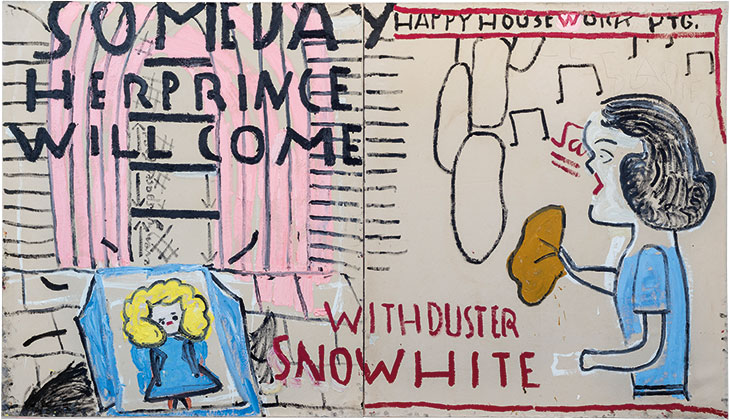
Snowwhite (3) with Duster (2018), Rose Wylie. Courtesy David Zwirner; © Rose Wylie
While Oxlade was alive and the children were young, Wylie didn’t paint. ‘I am a joy for feminists, because I had a husband who had much more visibility than me,’ she says dryly. ‘For a long time, he was the artist and I was the artist’s wife. But it was a trigger, it spurred me on.’ For years, ‘my whole work was with the children and in the house; ordinary work, like making curtains and clothes for the children, and making food. But I was completely involved, completely in it; it was creative.’ When she began to paint, she was unstoppable, finally having a creative life that was ‘my own, separate, totally absorbing’. Did Oxlade support her work? ‘He loved my paintings, but he didn’t like the way I got to them. He wouldn’t come into the studio. He used to say my cupboards were disgraceful.’ But Wylie continued doggedly, ‘with no encouragement, and no visibility; in fact, nothing but a sense of discouragement, because discouragement can grow out of a lack of encouragement.’ In an industry that privileges the young, she triumphed. ‘My age is a beacon,’ she concedes, for other women who want to paint.
Now, she continues to demonstrate what she calls an openness, a sense that ‘anything can come up in any form’. She notices things, she likes clutter, and is always curious, watching two or three films a week and always buying a Sunday paper. She works on large canvases, often panelled together, because ‘I like coverage. I like big. I like generosity rather than mean, picky, finnicky.’ Throughout our interview, she reels off lists of the things she likes, because of the possibilities of their shape or colour, or their pleasing simplicity: ‘Chocolate. Cake. Biscuits. Parsley stalks. A leek. Leeks are very good’; ‘I love cheap paper. Cheap sweets are superb. Grappa is much better than brandy. And I prefer cheap flowers, not those orchids in florists which are so tiresome. Small daffodils – I can be very fond of them.’ These are the sorts of things that appear in her work, things that reveal her delight in the everyday, but also her total rejection of artifice and affectation. In everything she does – from the materials she uses to her refusal to tidy her cupboards – Wylie is unwaveringly, quietly rebellious.
After we have finished talking, we go downstairs for lunch, sitting at the table beneath the beautifully dirty windows in the watery light. Pete steals a piece of pork pie and Wylie scoops him adoringly into her lap. She’ll start painting in the afternoon, going on into the night because there’s nothing to stop her. She doesn’t work to a routine; she does as she pleases, and it’s enough. What she seems to be asking for is simple: look at the work, not at age or ideas; don’t pigeonhole or tidy. Like the plants pushing in at the windows, determined and unfussy – let her be. This artist is flourishing.
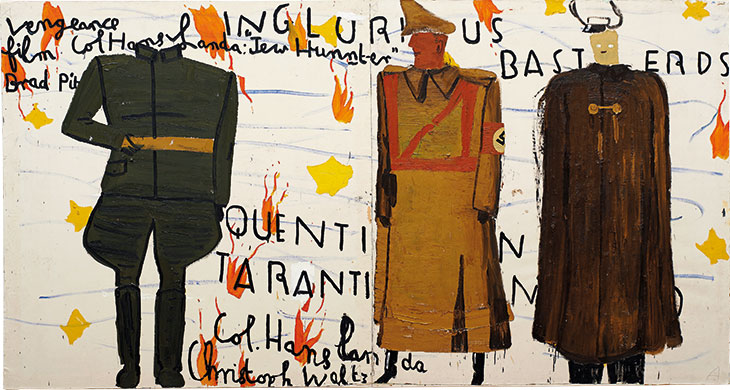
Inglourious Basterds (Film Notes) (2010), Rose Wylie
‘Let it Settle’ is at the Gallery at Windsor, Vero Beach, until 30 April; ‘Rose Wylie: Painting a Noun…’ is at David Zwirner, Hong Kong, until 22 February; ‘Rose Wylie’ is at Aspen Art Museum from 19 March–5 July.
From the January 2020 issue of Apollo. Preview and subscribe here.
Unlimited access from just $16 every 3 months
Subscribe to get unlimited and exclusive access to the top art stories, interviews and exhibition reviews.

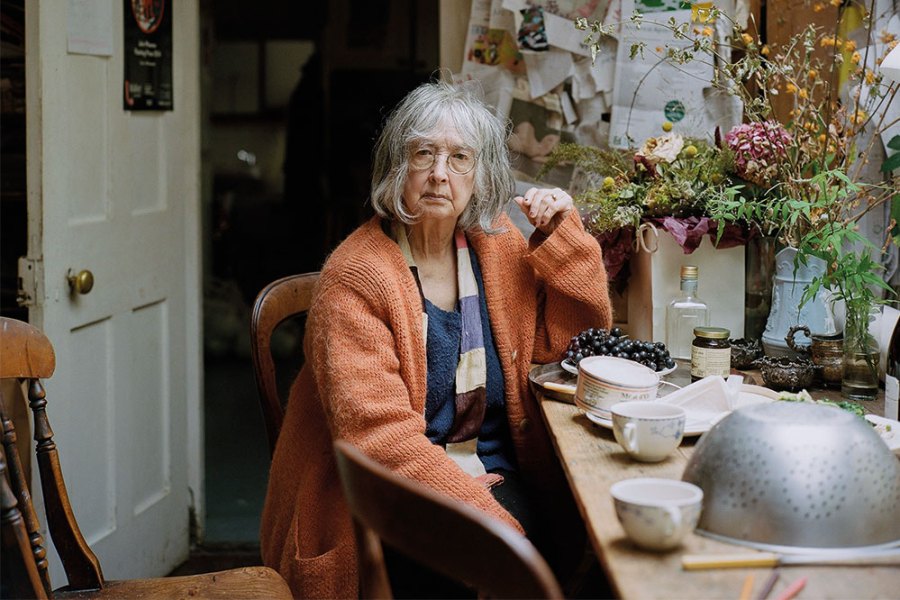
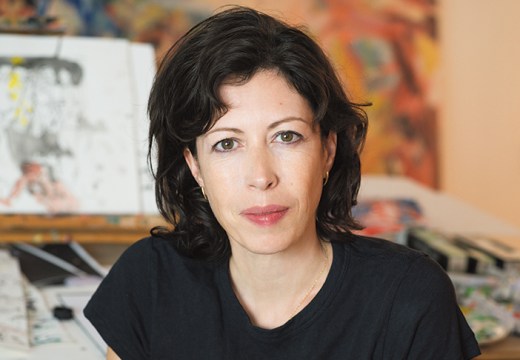
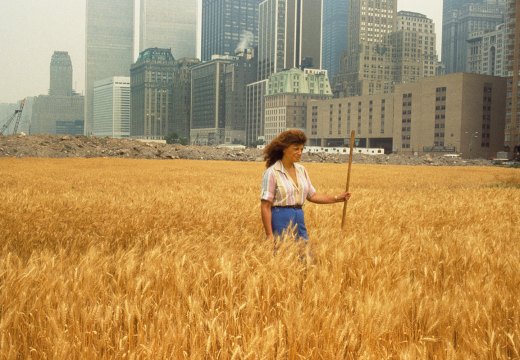
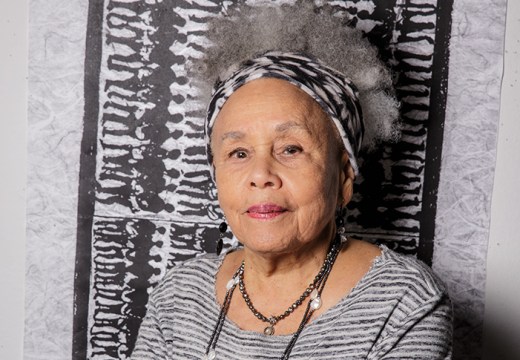









![Masterpiece [Re]discovery 2022. Photo: Ben Fisher Photography, courtesy of Masterpiece London](http://www.apollo-magazine.com/wp-content/uploads/2022/07/MPL2022_4263.jpg)
It’s time for the government of London to return to its rightful home